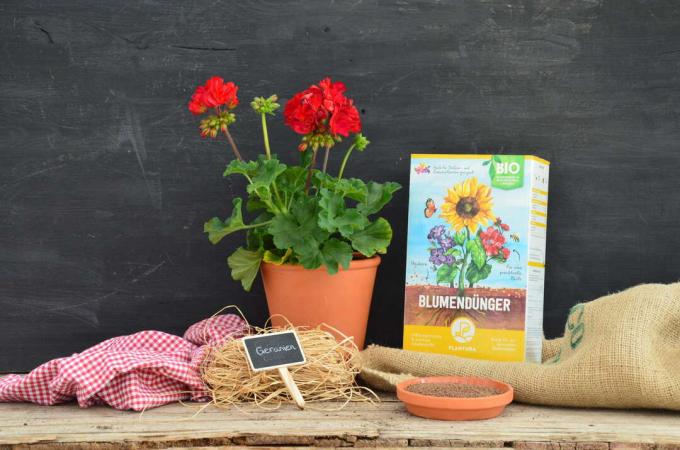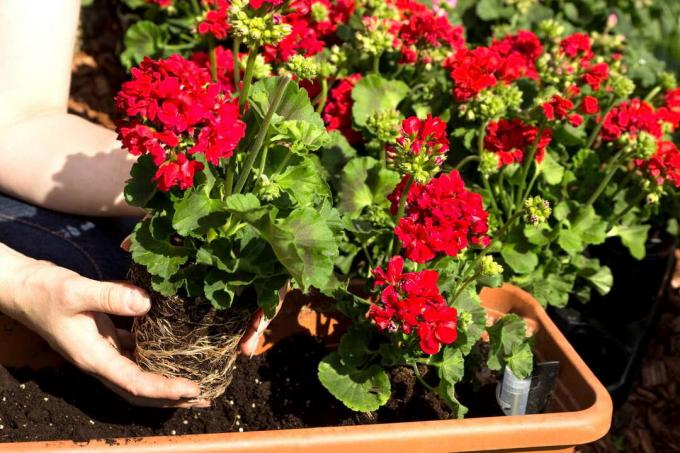Yellow leaves can indicate a lack of nutrients in geraniums. We explain how to correctly identify and combat chlorosis in geraniums.

Many also decorate your window sills and gardens Geraniums, which also contain pelargoniums (Pelargonium) to be named. They bloom in a wide variety of colors - from white to pink to various shades of red. Here you can find out what you can do about unsightly yellow discoloration on geranium leaves.
There are many different causes of chlorosis in geraniums - from nutrient deficiencies to temperature fluctuations.
contents
- Detect chlorosis in geraniums
- Reasons for chlorosis in geraniums
- Prevent chlorosis in geraniums
- Fix chlorosis in geraniums
Detect chlorosis in geraniums
Different types of chlorosis can appear in geraniums. For example, chlorotic yellow spots form all over the leaves, or chlorosis begins on the leaf margin or elsewhere on the leaves. What all chloroses have in common is the discoloration of the green leaves to yellowish, which can lead to the death of the leaf tissue, a so-called necrosis.
Reasons for chlorosis in geraniums
One of the most common causes of geranium chlorosis is nutritional deficiency. Depending on the type of deficiency, the chloroses arise in different places. Therefore, watch the geranium leaves closely to determine what nutrient deficiency it could be:
- Boron deficiency: necrotic and chlorostic spots form at the base of the leaves of the middle-aged leaves and spread along the veins
- Iron deficiency: yellowing of the young leaves between the leaf veins
- Copper deficiency: yellowing begins at the base of the leaf and spreads to the edge of the leaf
- Magnesium deficiency: yellowing of the older leaves between the leaf veins
- Phosphorus deficiency: chlorotic spots on the lower, older leaves that expand and turn reddish-purple in color

However, there are also abiotic causes that clog geraniums and trigger chlorosis. This includes the following causes:
- Sunburn: Indoor geraniums are often sunburned through the glass and then show yellow-brown spots; sunburn also causes necroses (dead brown leaf areas)
- Heat damage: At temperatures above 28 ° C, chlorosis and later necrosis can develop on the shoot tips
- Cold damage: Chlorosis forms at the shoot tips at temperatures below 8 ° C
- Temperature fluctuations: Cold nights paired with warm daytime temperatures can cause yellowing of the older leaves; in addition, red leaf margins can also appear
The growth conditions are also decisive for the occurrence of chlorosis in geraniums. Pests like that Whitefly (Trialeurodes vaporariorum), Spider mites (Tetranychidae) or mealybugs (Pseudococcidae) can also cause yellow discolouration, but this is only sucking damage to the insects.
Prevent chlorosis in geraniums
As mentioned above, chlorosis can have many different causes, so there are many methods to prevent chlorosis.
First and foremost, this includes an optimal supply of nutrients. With the right fertilization, you can prevent chlorosis from the outset. Also, make sure that your geraniums do not thrive in a pot that is too tight, as this will not only prevent it from becoming too nutrient deficiency, but also depletion of the soil and restriction of the roots' absorption capacity come. Provide the geraniums with plenty of nutrients right from the start by adding a fertilizer to the substrate while planting. Special flower fertilizers, such as Plantura, are suitable for this Organic flower fertilizer, which contains 4% nitrogen, 2% phosphorus and 7% potassium and guarantees your geraniums a good supply of nutrients. Here you can find out more about the ingredients and the application of the Plantura organic flower fertilizer. Information on Care of geraniums can be found in our special article.

Since chlorosis can also be caused by external factors such as temperature, you should avoid exposing your geraniums to temperatures below 8 ° C or above 28 ° C. Indoor geraniums often suffer from sun damage - especially the leaves that touch the window panes. Such locations should therefore be avoided.
With Yellow panels you can monitor whether the discoloration is caused by pests such as whitefly or for some other reason. You can simply put these in the flower boxes and regularly check whether animals are sticking to the glue layer. You can find out more about yellow boards and which pests they can be used for here.
Fix chlorosis in geraniums
If your geraniums suffer from chlorosis caused by a lack of nutrients, you can easily remedy this with a fertilizer. You can use special geranium fertilizers for this, which not only contain nitrogen, phosphorus and potassium, but usually also have an extra shot of trace elements. These fertilizers are often available in liquid form, so that you can simply mix them with the irrigation water and use it to fertilize the geraniums.
If your geraniums are planted in a pot that is too narrow, there is nothing to avoid repotting. The additional space and the fresh and nutrient-rich substrate will help the geranium get on its feet again. When repotting, you can also mix a fertilizer with the plant substrate immediately in order to optimally care for your geraniums. Here's everything you need to know for that Planting geraniums should know.

Summary of preventing geranium chlorosis:
- Balanced nutrient supply
- Use flower or geranium fertilizer
- Do not place in pots or flower boxes that are too narrow
- Avoid temperatures below 8 ° C and above 28 ° C
More information about the Care of geraniums can be found here in our special article.



